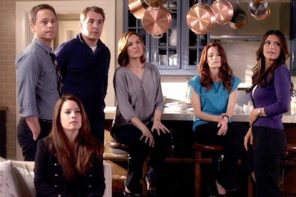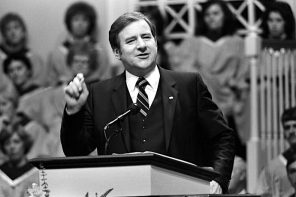“Whatever Happened to the American Left,” Michael Kazin’s substantial opinion piece in Sunday’s New York Times, delineates two axioms of conventional wisdom: that today’s conservative movement began in the 1970s and that the American left is MIA. Both contentions are debatable, but it’s not surprising to see them in the pages of a publication that presents both as political gospel in its reporting, commentaries, and editorials.
Equally problematic is that Kazin’s analysis, again following the Times’ lead, glosses over religion. Many journalists, academics, and pundits treat religious movements as political epiphenomena; or, to put it another way, that an essentially political reality is simply given a theological gloss. But millions of citizens beyond DC’s borders tend to think of politics as religious epiphenomena. Wonks may make a distinction, but in reality there’s very little difference.
So, rather than accept the well-worn narratives of the right’s post-’70s juggernaut and the left’s post-’60s demise, consider an alternative view of the “facts.” In this scenario, the melding of politics and economics into an implicitly religious worldview dates back to the 1930s. Moreover, the left is alive and well, and corporate media—far from being the tool of liberals—colludes with the right by pursuing its own agenda of covering only the news that’s safe, and profitable, to print.
Kazin asserts that “the current populist right originated among the articulate spokespeople and well-funded institutions that emerged in the 1970s.” The money may have originated there, but when it comes to ideology and language, historians including Allan J. Lichtman, Darren Dochuk, and Bethany Moreton have posited a timeline stretching back to the (last) Great Depression. As soon as FDR proposed the New Deal, coalitions of businessmen and religious leaders began their fight against the incipient socialism that they perceived in Roosevelt’s efforts to revive the economy and right the wrongs exposed by the financial calamity.
The coalition partners each had their particular motives. Businessmen fretted the bottom line, while religious leaders feared godless Communism. But many saw the overarching threat as one and the same: the New Deal would undo the American way of life predicated on radical individualism, hallowed by Christian teaching, and protected by the political system that had developed in tandem with free-market capitalism.
Funded by the heads of GM, Chrysler, and DuPont among other corporate leaders, conservatives organized groups, launched associations, built schools, published magazines, produced films, supported candidates, and groomed leaders to thwart the New Deal’s programmatic initiatives and rebut its philosophy of centralized government, workers’ rights, and the welfare state. These conservative tenets were second nature to many, but public opinion was mixed: Americans were wary of big government, but they desperately needed its help.
World War II changed the nature of the debate as business leaders took government jobs and watched their companies thrive in the wartime economy. Congress rolled back many of FDR’s pro-worker initiatives, and the right’s focus shifted from the New Deal to the New World Order. Conservative organizations still roiled local waters. In the 1950s, populist movements fought secular humanism in California’s public schools, and in the 1960s, millions mobilized around Barry Goldwater’s presidential campaign. By the late 1970s, strong grassroots groups in California, the Ozarks, the Midwest, and the South came together in the New Right/Christian Right impetus spurred by East Coast power brokers like Howard Phillips, Richard Viguerie, and Paul Weyrich. But the important thing to remember is that DC strategists would not have had a base without the decades-long history of movement building that had gone on in churches nationwide.
Even as the 1970s news media were “discovering” the religious right in Lynchburg and Virginia Beach, and declaring Falwell and Robertson its spokesmen, reporters turned a blind eye toward political organizing on the left. After the anti-war and civil rights movements, much of the progressive movement splintered into pockets of identity politics. Yet many in the religious community continued to do the hard work of local community building, whether through housing development, economic enterprise zones, or civic mentoring.
Simply put, their work did not jibe with the traditional news media values of conflict, currency, and power. These were regular people doing everyday work in the hope of effecting incremental change. Their stories went unreported for the same reasons that much of the right’s small-bore organizing went unremarked in the 1940s, ’50s, and ’60s: reporting on evolutionary social change is tougher than writing up this week’s conflict, and journalists have a hard time seeing how religion figures into almost every niche of American cultural ecology.
Q.E.D, Kazin notes the absence of a broad progressive coalition that once included “immigrant workers, middle-class reformers, muckraking journalists, and Social Gospelers.” But I would argue they’re hiding in plain sight. Some of them work for immigrant rights, others for food justice, still others for economic rights. You can read about their work at the Center for American Progress or see it in programs like Groundswell. Journalists report about it here at RD as well as in hundreds of blogs. Many are deeply religious, others just accept the idea that gross inequality is unconditionally wrong.
These voices and their stories rarely find their way to prime media real estate. Other than occasional feel-good piece about everyday saints (usually pegged to the holiday season), there is little coverage of men and women whose very work questions the underlying assumptions of contemporary corporate America.
Michael Kazin has written elsewhere that “intelligent, sober studies can make sense of how changing structures of power and ideas provide openings for challenges from below, while also shifting the basis on which a reigning order claims legitimacy for itself.” Exactly so. We need more such studies to understand the right’s long trajectory, the media’s muzzling of the left, and the role of religion in American political ideology.




